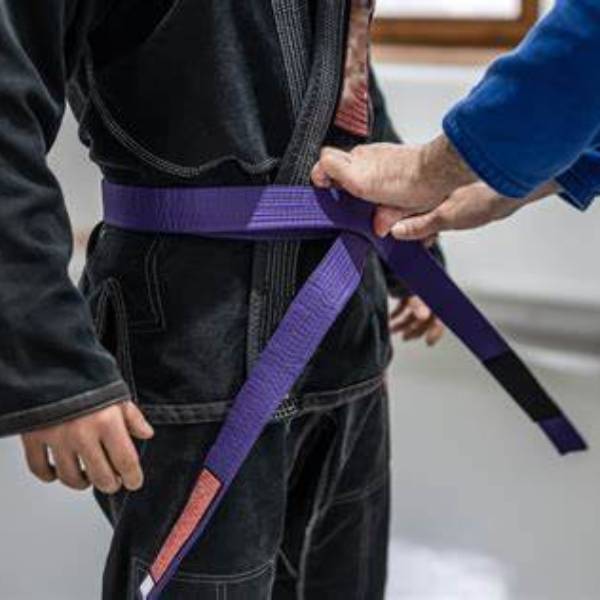Brazilian Jiu-Jitsu (BJJ) has gained immense popularity worldwide. More practitioners enter the sport every day. Many aspiring students wonder, “How long does it take to get a purple belt in BJJ?” Understanding this journey requires considering various factors. Let’s delve into the timeline and elements involved.

Understanding the Belt System in BJJ
In Brazilian Jiu-Jitsu, practitioners advance through a structured belt system. This system includes five primary belts: white, blue, purple, brown, and black. Each belt signifies different levels of skill and mastery. Students begin as white belts, often overwhelmed by the basics. They must learn essential techniques and concepts before moving to the next level. As students earn their blue belts, they gain more confidence and knowledge. They start to develop their own game and strategies. The journey continues to the purple belt, where students often experience significant growth. They begin to understand complex techniques and refine their skills through advanced training.
The Journey to Mastery
Climbing the ranks in Brazilian Jiu-Jitsu requires dedication and persistence. Many practitioners find motivation in the time and effort needed to advance. Each belt symbolizes years of hard work, discipline, and commitment. After achieving the purple belt, students often feel a sense of accomplishment. However, new challenges await them at the brown belt level. Practitioners must master intricate techniques and apply them effectively during sparring.
Once they reach the black belt, they can finally reflect on their journey. They realize the importance of perseverance and continuous learning in this martial art. The belt system not only marks progression but also fosters a deeper appreciation for the sport. As students advance, they connect with their instructors and peers. This bond enhances their experience and motivates them to push their limits. Ultimately, Brazilian Jiu-Jitsu becomes a lifelong journey intertwined with personal growth and community.
How Long Does It Take to Get a Purple Belt in BJJ?
Typically, earning a purple belt in Brazilian Jiu-Jitsu requires around 4 to 6 years of commitment. However, this timeline can differ significantly for each student. Training frequency remains one of the most important factors. Students who train multiple times each week often see quicker advancements than those who attend less frequently. Furthermore, students who dedicate extra time to drills and sparring typically accelerate their learning process. The depth of their understanding increases as they spend more time on the mat.
The Role of Instructor and Personal Dedication
Instructor recommendations also impact the progression toward a purple belt. Some instructors may emphasize different skills or techniques based on their teaching styles. This variability can lead to faster or slower frictions in the learning process. Additionally, personal dedication remains vital. Students who actively seek feedback and incorporate it into their training show improved techniques.

Those who set clear goals and maintain a strong mindset tend to progress more smoothly. Consequently, commitment and openness to learning generate a positive feedback loop, enhancing skill acquisition. Overall, students who combine these factors will likely find themselves achieving their purple belt sooner.
The Role of Consistency in Progressing
Getting a purple belt in Brazilian Jiu-Jitsu (BJJ) demands consistent training. Students who attend classes several times a week see quicker progress. They learn techniques more efficiently, and they develop a deeper understanding of moves. Regular sparring sessions enhance a student’s ability and confidence. When students consistently face different opponents, they refine their skills further. These experiences in sparring allow for practical application of learned techniques. Moreover, self-training at home plays a crucial role in development. Practicing techniques alone helps solidify understanding and improves muscle memory. Therefore, the commitment to regular training substantially influences how quickly one can earn their purple belt.
Building Competence Through Training
Commitment encourages students to challenge themselves and push their limits. As they attend more classes, their knowledge expands, and their skills deepen. Each technique learned builds upon previous knowledge, creating a solid foundation. This foundation opens doors for new strategies and adaptations in sparring.
Additionally, students who train with friends often gain valuable feedback. Constructive criticism fosters improvement; it helps hone skills and sharpen techniques. As students face various opponents, they gain insight into different styles. This experience enriches their overall understanding of BJJ. Ultimately, a focused approach to training, coupled with a supportive environment, drives success. Each training session serves as a stepping stone toward the purple belt. The journey may be long, but with dedication, students can achieve their goals.
The Influence of Coaching and Environment
The environment plays a crucial role in a student’s journey to earning a purple belt. A supportive instructor encourages students to push their limits, which boosts confidence. Furthermore, this guidance helps students identify areas for improvement. When instructors offer constructive feedback, learners quickly adapt their techniques. This positive reinforcement creates a cycle of improvement that hammers home skills. Students grow faster in this nurturing setting, enabling them to progress efficiently.

The Impact of Training Partners
Training with higher-ranked partners also significantly contributes to a student’s development. Experienced fighters share their knowledge and expose less-skilled students to diverse techniques. This exposure allows learners to refine their skills by seeing different strategies in action.
Moreover, practicing with skilled partners challenges students, pushing them to elevate their game. The right gym atmosphere fosters camaraderie, which encourages all members to improve together. With mutual support, everyone feels motivated to reach their goals faster. Overall, this combination of a positive environment and experienced guidance accelerates the journey to a purple belt.
How Competition Affects Progression
For many practitioners, competitions serve as significant motivators. Engaging in competitions can accelerate the journey to a purple belt. Facing diverse opponents challenges students to adapt and evolve. Competing teaches resilience and strategy. Individuals learn from losses and refine their techniques, making the training more focused. Thus, the competition paves a faster path to progress. Just as competitions accelerate progress in martial arts, finding the right backpacks for high school can streamline a student’s journey through their educational challenges.
Personal Motivation and Goals
The question, “How long does it take to get a purple belt in BJJ?” requires considering personal motivation. Each student has different aspirations and reasons for training. Some train for fitness, while others aim for competition. Those with specific goals often progress faster. A clear vision helps maintain motivation during long training sessions. Personal ambition transforms training into a fulfilling journey. For women aspiring to earn their black belt in BJJ, defining personal goals can significantly enhance their training experience and motivation along the journey.
Overcoming Challenges in Learning
Every BJJ practitioner faces challenges along the way. Injuries, plateaus, and mental fatigue can impede progress. Students need to acknowledge these hurdles. They should find ways to overcome them. Maintaining a positive mindset and setting realistic goals helps in overcoming obstacles. Adaptability is crucial in understanding how long it takes to get a purple belt in BJJ. As a BJJ white belt, embracing challenges and cultivating a positive mindset is essential for overcoming obstacles on the path to mastering this intricate martial art.
Conclusion: Embracing the Journey
In conclusion, how long does it take to get a purple belt in BJJ depends on various factors. While the average timeline ranges from 4 to 6 years, personal dedication proves vital. Consistent training, quality coaching, and motivation all play significant roles. Practitioners must enjoy the process, embracing each challenge along the way. Ultimately, the journey shapes not only skilled fighters but also dedicated students of life.




